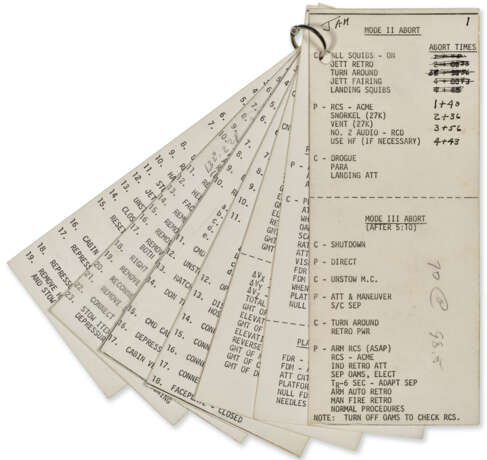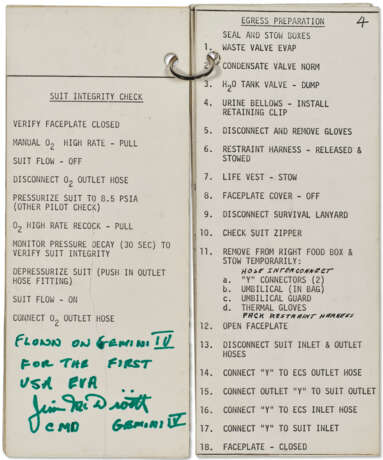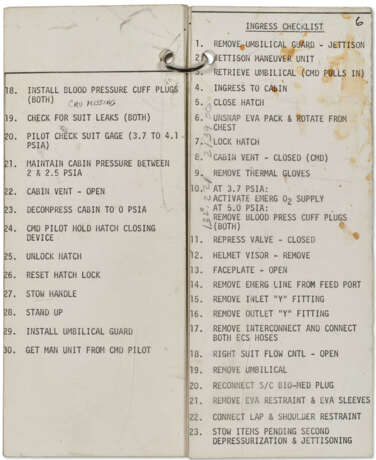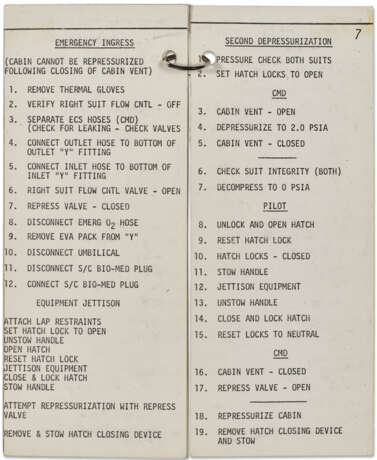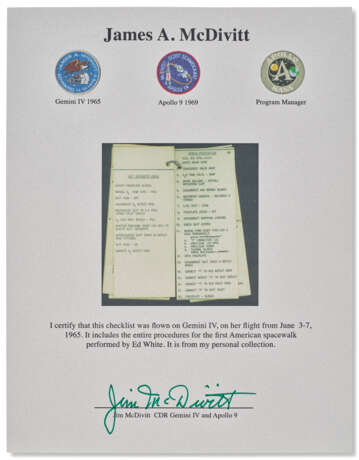ID 1279138
Los 19 | SPACEWALK CHECKLIST, FLOWN AND ANNOTATED
Schätzwert
$ 60 000 – 80 000
GEMINI IV, 3 JUNE 1965
13 printed pages on seven cue cards, fastened with metal book ring. Annotated in pencil on pages 1, 1v, 5v, and 6, being notes made by the Gemini IV astronauts during the mission. Annotated in ink with pre-flight emendations by ground control on pages 1, 4, and 5. Signed and inscribed "FLOWN ON GEMINI IV FOR THE FIRST USA EVA / JIM MCDIVITT CMD GEMINI IV" on cue card 3. With signed provenance letter by James McDivitt.
The original and complete set of procedures for America’s first spacewalk. Ed White spent 21 minutes outside of his Gemini capsule on 3 June 1965, traveling 6500 miles or about a quarter of the way around the Earth. This checklist was annotated by the astronauts in-flight and bears stains on the Ingress portion—evoking the near disastrous hatch malfunction.
The first EVA (extra-vehicular activity in space) was performed by cosmonaut Alexei Leonov on 18 March 1965 who spend 12 minutes outside the Voskhod 2, maneuvering himself simply by pulling on the tether that connected him to the craft. The Soviets had launched Sputnik in 1957 a few months before the US's first satellite, and put the first man in space in 1961, but by this point the U.S. was gaining on the U.S.S.R., and the EAV was the last major milestone reached first by the Soviets. Leonov's EVA was extremely difficult, and it would be four years before the Soviets attempted a second one. By contrast White's EVA was not only the first American EVA but also the first to use a hand-held maneuvering unit and the first to have a checklist. White enjoyed himself so much on the spacewalk that he famously had to be ordered to return to the craft. From the mission transcript:
McDivitt: “Okay. Just a second … you’re right in front, Ed. You look beautiful.”
White: “I feel like a million dollars."
...
McDivitt: “Okay. Okay. Don’t wear yourself out now. Just come on in.”
White: “I’m trying to get a picture of the spacecraft now.”
McDivitt: “Ed, come on in here. Let’s get back here before it gets dark.”
White: Sighed, “Okay. This is the saddest moment of my life.”
McDivitt: “Well, you’re going to find a sadder one when we have to come down from this whole thing.”
White: “I’m coming.”
McDivitt: “Have you any messages for us, Houston?”
Grissom: “Are you getting him back in?”
When Ed White re-entered the spacecraft, however, the jubilation quickly turned to concern. White and McDivitt closed the hatch and grabbed the ratchet handle to secure it. To their shock, the handle failed to catch. The hatch seal had been exposed to the vacuum of space and the intense cold had stiffened it more than anticipated. As McDivitt explained to Houston Capcom: “As [White] got back into the spacecraft, we had a considerable amount of difficulty with the hatch. First we lifted the ratchet portion of the hatch to engage. After we got that engaged, we couldn’t get the hatch closed down far enough. Actually we started pulling down on the locking handles to get the dogs out. So, we had a rather exciting time. It went on for – I think we were 44 minutes after we started the EVA. I was looking at my event timer, which I had started when Ed exited the spacecraft. At 44 minutes we still didn’t have the hatch closed. We were trying to take things calm, cool and collected so we didn’t get things all screwed up. Finally, by my pulling as hard as I could to get the hatch-closing device, and Ed pulling down as best he could we were able to force him down into the seat and get the hatch closed fully. Ed seemed to be up much higher today than he had been in any of our zero-g EVA’s in the airplane.”
Card six of the present checklist is the one with the relevant ingress procedures and is notably stained, quite probably with blood from McDivitt's fingers caused by injury when he was pressing down hard on the gears of the ratchet handle. Although the mission plan called for re-opening the hatch to discard White's bulky EVA equipment, McDivitt understandably elected not to risk re-opening the hatch.
McDivitt and White, who were also the first space crew (all previous spaceflights had been single-man only) orbited Earth for two and a half more days before making a successful reentry. President Lyndon B. Johnson came to Houston to congratulate them, and he promoted both astronauts to the rank of lieutenant colonel and would soon present them with the NASA Exceptional Service Medal.
8 x 3 ¼ in. (20.3 x 8.3 cm.)
Provenance
James McDivitt (1929-2022), Commander of the Gemini 4 and Apollo 9 missions.
Rolf Erdmann; Bonhams, New York, 21 April 2015, lot 31.
Acquired at the above sale by the late owner.
| Kategorie des Auktionshauses: | Bücher und Handschriften, Gedruckte Bücher |
|---|
| Kategorie des Auktionshauses: | Bücher und Handschriften, Gedruckte Bücher |
|---|
| Adresse der Versteigerung |
CHRISTIE'S 8 King Street, St. James's SW1Y 6QT London Vereinigtes Königreich | |
|---|---|---|
| Vorschau |
| |
| Telefon | +44 (0)20 7839 9060 | |
| Aufgeld | see on Website | |
| Nutzungsbedingungen | Nutzungsbedingungen |
